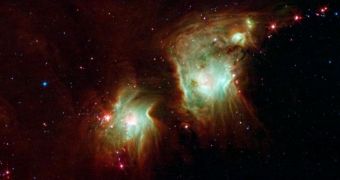In this recently-published composite image, the NASA Spitzer Space Telescope reveals the amazing beauty of the Messier 78 star forming region in the constellation of Orion. The object looks as if depicting two blazing eyes, set on a distant target.
Data included in this image were snapped in infrared wavelengths, but not even Spitzer's keen IR vision could penetrate too deep within the dusty nebula. When this exact image is seen in visible light, its brightest parts are in fact obscured by massive dust clouds.
The two nebulae that are apparent in this image are hollows in a huge mass of cosmic dust and gas, astronomers explain. In visible light, this structure is visible a bit to the northeast of Orion's Belt, the famous feature of the Orion constellation after which the Egyptian pyramids were laid out.
This particular image was put together from data collected by two Spitzer instruments, in three colors and three wavelength ranges – at 3.6 and 4.5 microns (blue), 5.8 and 8 microns (green) and 24 microns (red).

 14 DAY TRIAL //
14 DAY TRIAL //